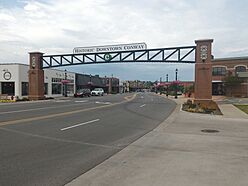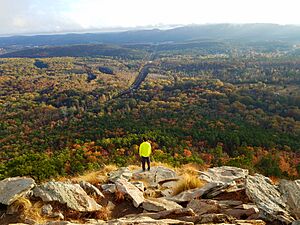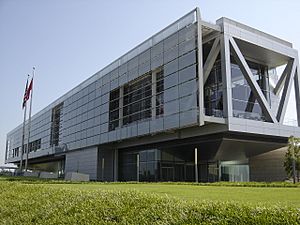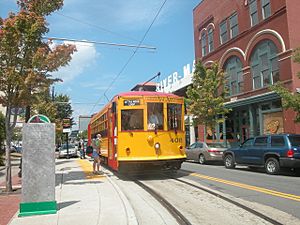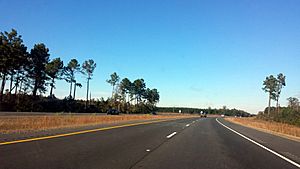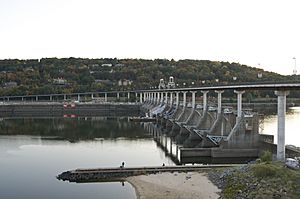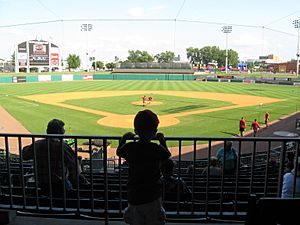Central Arkansas facts for kids
Quick facts for kids
Central Arkansas
|
|
|---|---|
| Little Rock-North Little Rock-Conway, AR Metropolitan Statistical Area |
|
|
From top to bottom: Little Rock, North Little Rock, Conway
|
|

Components of the Little Rock–
North Little Rock, AR CSA Little Rock–North Little Rock–Conway, AR Pine Bluff, AR MSA Searcy, AR μSA |
|
| Country | |
| State | |
| Principal cities | Little Rock North Little Rock Conway |
| Area | |
| • Urban | 669 km2 (258.3 sq mi) |
| • MSA | 10,580.6 km2 (4,085.18 sq mi) |
| • CSA | 18,519.2 km2 (7,150.31 sq mi) |
| Population
(2022)
|
|
| • Urban | 461,864 (US: 89th) |
| • MSA | 748,031 (US: 81st) |
| • CSA | 912,604 (US: 62nd) |
| GDP | |
| • MSA | $47.322 billion (2022) |
| Time zone | UTC-6 (CST) |
| • Summer (DST) | UTC-5 (CDT) |
| Area code(s) | 501 & 870 |
Central Arkansas, also known as the Little Rock metro, designated by the United States Office of Management and Budget as the Little Rock-North Little Rock-Conway Metropolitan Statistical Area, is the most populous metro area in the U.S. state of Arkansas. With an estimated 2020 population of 748,031, it is the most populated area in Arkansas. Located at the convergence of Arkansas's other geographic regions, the region's central location make Central Arkansas an important population, economic, education, and political center in Arkansas and the South. Little Rock is the state's capital and largest city, and the city is also home to two Fortune 500 companies, Arkansas Children's Hospital, and University of Arkansas for Medical Sciences (UAMS).
Contents
History
The site known as "little rock" along the Arkansas River was found by explorer Bernard de la Harpe in 1722. The territorial capitol had been located at Arkansas Post in Southeast Arkansas since 1819, but the site had proven unsuitable as a settlement due to frequent flooding of the Arkansas River. Over the years, the "little rock" was known as a waypoint along the river, but remained unsettled. A land speculator from St. Louis, Missouri who had acquired many acres around the "little rock" began pressuring the Arkansas territorial legislature in February 1820 to move the capital to the site, but the representatives could not decide between Little Rock or Cadron (now Conway), which was the preferred site of Territorial Governor James Miller. The issue was tabled until October 1820, by which time most of the legislators and other influential men had purchased lots around Little Rock. The legislature moved the capital to Little Rock, where it has remained ever since.
Geography
Central Arkansas is located in the Southern United States (commonly known as the South in the US), and within a subregion commonly known as the Deep South, although it is influenced by Upper South culture. The South is a distinct cultural region reliant upon a plantation economy in the 18th and 19th century, until the secession of the Confederate States of America and the Civil War.
The region is the point of convergence for five other Arkansas regions: the Ozarks to the north, the Arkansas River Valley & the Ouachita Mountains to the west, the Arkansas Delta to the east, and Piney Woods to the southwest.
The Arkansas River crosses the region, and serves as the dividing line between Little Rock and North Little Rock. The Arkansas is an important geographic feature in Central Arkansas, requiring long bridge spans but allowing barge traffic to the Port of Little Rock and points upriver.
Demographics
| Historical population | |||
|---|---|---|---|
| Census | Pop. | %± | |
| 1840 | 7,411 | — | |
| 1850 | 10,538 | 42.2% | |
| 1860 | 20,804 | 97.4% | |
| 1870 | 42,605 | 104.8% | |
| 1880 | 76,558 | 79.7% | |
| 1890 | 109,569 | 43.1% | |
| 1900 | 134,590 | 22.8% | |
| 1910 | 173,926 | 29.2% | |
| 1920 | 207,941 | 19.6% | |
| 1930 | 233,056 | 12.1% | |
| 1940 | 249,799 | 7.2% | |
| 1950 | 288,070 | 15.3% | |
| 1960 | 334,011 | 15.9% | |
| 1970 | 396,462 | 18.7% | |
| 1980 | 494,758 | 24.8% | |
| 1990 | 535,034 | 8.1% | |
| 2000 | 610,518 | 14.1% | |
| 2010 | 699,757 | 14.6% | |
| 2020 | 748,031 | 6.9% | |
| U.S. Decennial Census 1790–1960 1900–1990 1990–2000 |
|||
Central Arkansas includes both the Little Rock-North Little Rock-Conway MSA, though the broader Little Rock CSA is also considered Central Arkansas. The MSA is defined by the United States Office of Management and Budget as Faulkner, Grant, Lonoke, Perry, Pulaski and Saline counties. The CSA definition adds the Pine Bluff metropolitan area adding Cleveland, Jefferson, and Lincoln counties, and the Searcy Micropolitan Area, which adds White County.
It is the core of the broader Little Rock-North Little Rock Combined Statistical Area (CSA). Its economic, cultural, and demographic center is Little Rock, Arkansas's capital and largest city. The Little Rock Combined Statistical area spans ten counties and had an estimated population of 905,847 in 2016.
Prior to 2002, the area consisted of four core counties: Pulaski, Faulkner, Saline and Lonoke. The area was later expanded to include adjoining Perry County to the west, and Grant County to the south. The city of Conway was designated as a third principal city for the MSA by 2007.
| County Ref. |
Population | Land mi2 |
Land km2 |
Pop. /mi2 |
Pop. /km2 |
|---|---|---|---|---|---|
| Pulaski County | 393,250 | 759.76 | 1,967.77 | 503.8 | 194.52 |
| Faulkner County | 122,227 | 647.88 | 1,678.00 | 174.8 | 67.49 |
| Saline County | 118,703 | 723.60 | 1,874.12 | 148.0 | 57.14 |
| Lonoke County | 72,228 | 770.73 | 1,996.18 | 88.7 | 34.25 |
| Grant County | 18,082 | 631.81 | 1,636.38 | 28.3 | 10.93 |
| Perry County | 10,132 | 551.40 | 1,428.12 | 18.9 | 7.30 |
| Central Arkansas | 734,622 | 4,085.18 | 10,580.57 | 179.8 | 69.42 |
| Jefferson County | 70,016 | 870.75 | 2,255.23 | 88.9 | 34.32 |
| Lincoln County | 13,705 | 561.52 | 1,454.33 | 25.2 | 9.73 |
| Cleveland County | 8,241 | 597.78 | 1,548.24 | 14.5 | 5.60 |
| Pine Bluff MSA | 91,962 | 2,030.05 | 5,257.81 | 45.3 | 17.49 |
| Searcy μSA | 79,263 | 1,035.08 | 2,680.84 | 74.5 | 28.76 |
| CSA | 905,847 | 7,150.31 | 18,519.22 | 126.7 | 48.92 |
| Arkansas | 2,988,248 | 52,035.48 | 134,771.27 | 56.0 | 21.62 |
Communities
Communities are categorized based on their populations in the 2000 U.S. Census.
Places with more than 100,000 inhabitants
- Little Rock (principal city) (202,591)
Places with 50,000 to 100,000 inhabitants
- North Little Rock (principal city) (64,591)
- Conway (principal city) (64,134)
Places with 10,000 to 50,000 inhabitants
- Pine Bluff (41,253)
- Benton (35,014)
- Sherwood (32,731)
- Jacksonville (28,364)
- Cabot (23,776)
- Searcy (23,098)
- Maumelle (19,251)
- Bryant (16,688)
- Hot Springs Village (partial) (15,861)
Places with 1,000 to 10,000 inhabitants
|
|
Places with 500 to 1,000 inhabitants
|
Places with fewer than 500 inhabitants
|
Population trends
| Year | Metropolitan Statistical Area |
Combined Statistical Area |
|---|---|---|
| 2020 Census | 748,031 | 912,604 |
| 2014 est. | 729,135 | 902,443 |
| 2005 est. | 645,706 | 820,846 |
| 2000 Census | 610,518 | 785,024 |
Economy
The Little Rock Regional Chamber of Commerce, the oldest association in Arkansas, has produced the following list of largest employers in Central Arkansas.
| Employer | Number of employees |
|---|---|
| State of Arkansas | 32,200 |
| Local government | 28,800 |
| Federal government | 9,200 |
| University of Arkansas for Medical Sciences | 8,500 |
| Baptist Health | 7,000 |
| Little Rock Air Force Base | 4,500 |
| Acxiom | 4,380 |
| Little Rock School District | 3,500 |
| Central Arkansas Veterans Healthcare System | 3,500 |
| Entergy Arkansas | 2,740 |
| Pulaski County Special School District | 2,700 |
| AT&T | 2,600 |
| CHI St. Vincent Health System | 2,600 |
| Arkansas Children’s Hospital | 2,470 |
| Dillard's | 2,400 |
| Verizon Wireless | 2,000 |
| Union Pacific Railroad | 2,000 |
| Arkansas Blue Cross Blue Shield | 1,800 |
| Dassault Falcon Jet Corp. | 2,000 |
| CenterPoint Energy | 1,800 |
Source: Little Rock Regional Chamber of Commerce
Higher education
Notable colleges and universities
| School | Enrollment | Location | Type | Nickname | Athletic Affiliation (Conference) |
|---|---|---|---|---|---|
 University of Arkansas at Little Rock |
11,848 | Little Rock | Public State University |
Trojans | NCAA Division I (Sun Belt) Non-Football |
 University of Central Arkansas |
11,487 | Conway | Public State University |
Bears and Sugar Bears | NCAA Division I FCS (Southland) |
 Hendrix College |
1,348 | Conway | Private liberal arts college |
Warriors | NCAA Division III (SAA) |
Arts and culture
- Quapaw Quarter – start of the 20th century Little Rock consists of three National Register historic districts with at least a hundred buildings on the National Register of Historic Places.
Museums
- The Arkansas Museum of Fine Arts, the state's largest cultural institution, is a museum of art and an active center for the visual and performing arts.
- The Museum of Discovery features hands-on exhibits in the fields of science, history and technology.
- The William J. Clinton Presidential Center and Heifer Village include the Clinton presidential library and the offices of the Clinton Foundation and the Clinton School of Public Service. The Library facility, designed by architect James Polshek, cantilevers over the Arkansas River, echoing Clinton's campaign promise of "building a bridge to the 21st century". The archives and library have 2 million photographs, 80 million pages of documents, 21 million e-mail messages, and nearly 80,000 artifacts from the Clinton presidency. The museum within the library showcases artifacts from Clinton's term and has a full-scale replica of the Clinton-era Oval Office. Opened on November 18, 2004, the Clinton Presidential Center cost $165 million to construct and covers 150,000 square feet (14,000 m2) within a 28-acre (113,000 m2) park.
- The Historic Arkansas Museum is a regional history museum focusing primarily on the frontier time period.
- The MacArthur Museum of Arkansas Military History and Macarthur Park opened in 2001, the last remaining structure of the original Little Rock Arsenal and one of the oldest buildings in central Arkansas, it was the birthplace of General Douglas MacArthur who went on to be the supreme commander of US forces in the South Pacific during World War II.
- The Old State House Museum is a former state capitol building now home to a history museum focusing on Arkansas's recent history.
- The Mosaic Templars Cultural Center is a nationally accredited, state-funded museum and cultural center focusing on African American history and culture in Arkansas.
- The ESSE Purse Museum illustrates the stories of American women's lives during the 1900s through their handbags and the day-to-day items carried in them.
- The Little Rock Central High School is still a functioning high school but contains a museum, visitors center, and park on the school grounds.
- The Arkansas National Guard Museum
- The Simmons Bank Arena with the Arkansas Sports Hall of Fame Museum.
- The Arkansas Inland Maritime Museum, and the Navy tug Hoga (YT-146), a survivor of the attack on Pearl Harbor, and the USS Razorback (SS-394), which was at the surrender in Tokyo Bay
- The Faulkner County Museum focuses on the prehistory, history, and culture of Faulkner County. Located inside the former Faulkner County Jail, it displays photos, artifacts, equipment, household items, clothing, and arts and crafts by local artists.
- Plantation Agriculture Museum, located in Scott displays artifacts from Arkansas's agricultural history in large farming operations, particularly cotton cultivation. The museum is housed in a circa-1912 general store building, and also features a restored 1912 cotton gin, Seed Warehouse #5, and chronicles the period from Arkansas's statehood to the end of World War II focusing on tenant farming and agricultural mechanization.
- Plum Bayou Mounds Archeological State Park, located in Scott, focuses on the site of a Native American civilization that lived just east of present-day Scott nearly 1,000 years ago. Mounds at the park comprise one of the most significant remnants of Native American life in the state, and are listed on the National Register of Historic Places. The Arkansas Archeological Survey, part of the University of Arkansas system, maintains its Plum Bayou Research Station and laboratory in the park's visitor center.
- The Scott Plantation Settlement, a grouping of relocated buildings including the wooden Cotton Belt Railroad Depot that served Scott, collected to represent the area's plantation-era heritage (much in the same fashion as Little Rock's Historic Arkansas Museum).
- Marlsgate Dortch Plantation, the area's best known example of a plantation family home, was constructed on the Lonoke County side by the Dortch family early in the 20th century and is a popular site for weddings and receptions today.
- Vogel Schwartz Sculpture Garden
- Witt Stephens Jr. Central Arkansas Nature Center
- The Galleries at Library Square
- Hearne Fine Art Gallery
- Arkansas School for the Deaf Historical Museum
- Baum Gallery
- Arkansas Game and Fish Foundation Sports Complex
- Jacksonville Guitar Center and Museum
- Jacksonville Museum of Military History
- Reed’s Bridge Battlefield Heritage Park
Music and theater
- The Arkansas Repertory Theatre is the state's largest nonprofit professional theatre company. A member of the League of Resident Theatres (LORT D), The Rep has produced more than 300 productions, including 40 world premieres, in its building in downtown Little Rock. Producing Artistic Director John Miller-Stephany leads a resident staff of designers, technicians and administrators in eight to ten productions for an annual audience in excess of 70,000 for MainStage productions, educational programming and touring. The Rep produces works from contemporary comedies and dramas to world premiers and the classics of dramatic literature.
- The Community Theatre of Little Rock, founded in 1956, is the area's oldest performance art company.
- The Arkansas Symphony Orchestra performs over 30 concerts a year and many events.
- The Robinson Center Music Hall is the main performance center of the Arkansas Symphony Orchestra.
- The Wildwood Park for the Arts is the largest park dedicated to the performing arts in the South; it features seasonal festivals and cultural events.
- The Argenta Historic District and Argenta Plaza
Parks and Recreation
- The River Market Artspace and Park
- T. R. Pugh Memorial Park, location of the Old Mill in the movie Gone With The Wind
- Arkansas Arboretum – at Pinnacle Mountain; it has a trail with flora and tree plantings.
- Little Rock Zoo – consists of at least 725 animals and over 200 species
- Willow Springs Water Park – one of the first water theme parks in the U.S., built in 1928.
- Bayou Meto Urban Canoe Trail
Infrastructure
Major highways
 Interstate 30
Interstate 30
 Interstate 40
Interstate 40
 U.S. Highway 64
U.S. Highway 64 U.S. Highway 65
U.S. Highway 65 U.S. Highway 67
U.S. Highway 67 U.S. Highway 70
U.S. Highway 70 U.S. Highway 165
U.S. Highway 165 U.S. Highway 167
U.S. Highway 167 U.S. Highway 270
U.S. Highway 270
Aviation
The Clinton National Airport in Little Rock is the largest commercial airport in the state, with more than 100 flights arriving or departing each day and nonstop jet service to eighteen cities. North Little Rock Municipal Airport, located across the Arkansas River, is designated as a general aviation reliever airport for Clinton National by the Federal Aviation Administration (FAA). Central Arkansas also has several smaller municipally owned general aviation airports: Conway Airport at Cantrell Field in Conway, Saline County Regional in Benton, Grider Field in Pine Bluff.
Professional sports
The city of Little Rock is home to the Arkansas Travelers. The Travelers are the AA Minor League Baseball affiliate of the Seattle Mariners. They compete in the Texas League and play their home games at Dickey–Stephens Park.
See also
 In Spanish: Área metropolitana de Little Rock-North Little Rock-Conway para niños
In Spanish: Área metropolitana de Little Rock-North Little Rock-Conway para niños




